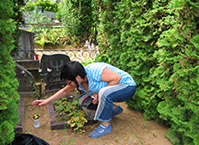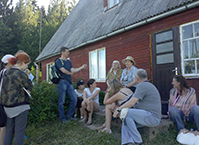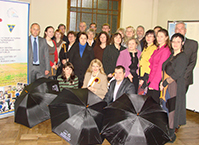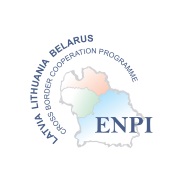E-MUSEUM “VITAMEMORIAE”: COLLECTION AND RESEARCH
Foto
To record people’s life stories, traditions, customs, rituals, rare photographs, old documents, ethnographic differences in funeral rites, etc. the researchers of Daugavpils University and Yanka Kupala Grodno State University carried out field studies in LV and BY territories: in the villages of Krāslava, Rēzekne, Daugavpils regions (Asūne, Foļvarka, Kruki, Skrudaliena, Indra, etc.) and in Belarus (Braslav and Vitebsk districts). The field studies were implemented in the framework of the project “Popularization of the Centres of Oral History in the LV – BY Cross-Border Area”, ID Nr. LLB–2–143, of the Cross Border Cooperation Programme Latvia–Lithuania–Belarus implemented within the framework of the European Neighbourhood and Partnership Instrument 2007–2013.
During the research and the expeditions, the project implementers collected, segmented, transcribed, and digitized the audio-visual materials (audio and video records, photo evidence). To make the collection of the E-Museum more complete, the field researchers and cemetery researchers of Daugavpils University and Grodno University will segment and systematize the audio-visual materials collected during oral history, cemetery research, folklore and dialectology expeditions of the previous years that until now have not been used, aiming at including the best and most valuable segments of the collection into the E-Museum.
The story tellers whose life stories make the input of the E-Museum are people of various generations, mostly elderly people. The childhood of aged people, who at present are about 80 years old, proceeded in the 1930s, therefore the segmented audio-visual units included in the E-Museum chronologically begin from 1929 and can describe only the respondents’ childhood memories. The memory of the older generation is particularly important for the anthropological and historical research – it shifts the time borders, allows for moving to the events of the past through the viewpoints of those who have experienced those times. The facts can be found in chronicles, but what the witnesses of that time can reveal give the memories colour, scent, involve one into mutual emotional experience. The witnesses of the epoch tell about the events form the viewpoint of their own experience.
To motivate the respondents to share their life stories, the project field researchers used Paul Thomson’s oral history research method – enlarged vision of social history where diverse groups of the society are brought together and share common historical experience.
The research basis is the methodology of a semi-structured interview that envisages focused (guided) reconstruction of the past events and an interviewer only helps the respondents to reconstruct the past.
The oral history collection of the E-Museum is envisaged to be used not only by specialists but also by a greatest possible range of non-specialists, therefore, departing from the academic tradition envisaging a complete script and transcript (written transcription of an audio or video record) of life stories, the project experts agreed to segment 360 most vivid, colourful, expressive, unusual, typological or extraordinary audio-visual units (photo, video and audio testimonies) – thematically complete excerpts, and to systematize them according to the thematic plan that would encompass both the historical processes of the 20th century (from the 1920s-30s) and the most essential events of an individual’s life.
ACCESSIBILITY OF THE COLLECTION
The interviews included into the collection are arranged according to the principle of historicism, anthropologism and personalia, indicating the author’s name and the interviewer’s name and surname.
-
The Church choir and preparation for a general holiday of a song and dance in Daugavpils in 1940
Story-teller: “I liked to sing. You see, in the countryside, there was nothing else, we went to church. And in the church there was an educated organ player, he had arrived from Riga, right …
Researcher: Dr. philol. Gatis Ozoliņš, Daugavpils Universitāte
Categories: Confessional and international relations, Helena Bilinska
-
About studies and proffesion
Story-teller: “There were no schools, no schools were here. During the war there was such a village Bērzenieki, there was a Russian school, a small one, Russian school. I don’t know for …
Researcher: Dr. philol. Jeļena Koroļova, Daugavpils Universitāte
Categories: School, Helena Bilinska
-
Аbout the games and toys in the childhood
Story-teller: “I spent my childhood in herding. I herded alone. If there were some children, then they simply ran to me, but the basic game was tripakas or hide-and-seek. Oh, and then it didn& …
Researcher: Dr. philol. Gatis Ozoliņš, Daugavpils Universitāte
Categories: Holidays and traditions, Anton Slishan
-
About the beer preparation
Story-teller: “You see, growing old I started to think that I should start making beer, whether I manage or not, since I have great experience. At first, I remember how my father made it, then …
Researcher: Dr. philol. Gatis Ozoliņš, Daugavpils Universitāte
Categories: Holidays and traditions, Anton Slishan
-
Masks processions
Story-teller: “Pagan traditions? Līgo [Midsummer night] festivities! This is a pagan tradition! Now, it is not so much, but it is maintained, maintained, how, you see, how, you see, how, you …
Researcher: Dr. philol. Gatis Ozoliņš, Daugavpils Universitāte
Categories: Holidays and traditions, Anton Slishan
-
Formation of the folklore movement in Upitе
“In fact, the folklore movement as such has existed here since the prehistoric times, this is clear. But its history as an organized folklore movement is newer. The first variant was in the …
Researcher: Dr. philol. Gatis Ozoliņš, Daugavpils Universitāte
Categories: Holidays and traditions, Anton Slishan
-
Аbout belonging to communist
Story-teller: “When I attended school, there were no Octobrists yet, I, together with Leonards Lazdiņš, flatly refused to join the pioneers. He is now an artist in Rēzekne, he finished …
Researcher: Dr. philol. Gatis Ozoliņš, Daugavpils Universitāte
Categories: Man and authority, Anton Slishan
-
The parable about ancient latgalets
Story-teller: “A grave was dug for one person and then a coffin was found. And, of course, everybody was shocked, that, what a coffin, if there were no mounds seen in the place they had dug. So …
Researcher: Dr. philol. Gatis Ozoliņš, Daugavpils Universitāte
Categories: Residence and weekdays, Anita Locmele
-
The parable about the hidden treasure conducted and the old ancient settlement
Story-teller: “But then again there is a belief that treasure is hidden in the place, where the evil spirit often lures. However, scientists explain that there is something connected with …
Researcher: Dr. philol. Gatis Ozoliņš, Daugavpils Universitāte
Categories: Holidays and traditions, Anita Locmele
-
About Dansk settlement
Story-teller: “We know, that Latgalians also were the raiders, and they needed that, I don’t know, slaves or what, or maybe there were a lot of deaths during some periods of diseases, I …
Researcher: Dr. philol. Gatis Ozoliņš, Daugavpils Universitāte
Categories: Residence and weekdays, Anita Locmele










